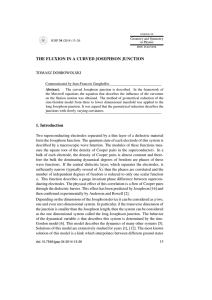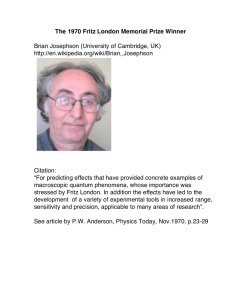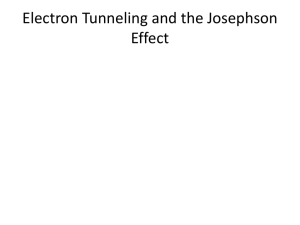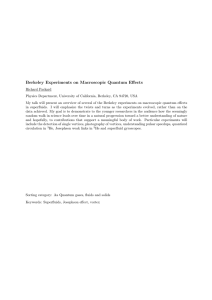Critical current of a long Josephson junction in the presence... Mikhail V. Fistul and Gabriele F. Giuliani
advertisement
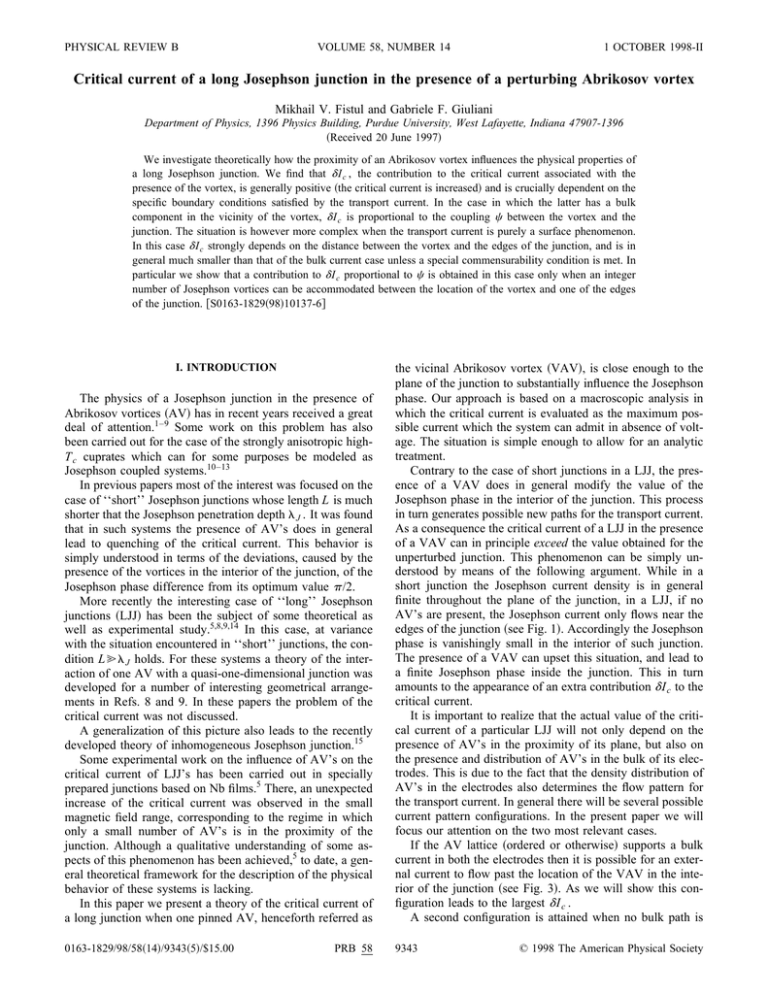
PHYSICAL REVIEW B VOLUME 58, NUMBER 14 1 OCTOBER 1998-II Critical current of a long Josephson junction in the presence of a perturbing Abrikosov vortex Mikhail V. Fistul and Gabriele F. Giuliani Department of Physics, 1396 Physics Building, Purdue University, West Lafayette, Indiana 47907-1396 ~Received 20 June 1997! We investigate theoretically how the proximity of an Abrikosov vortex influences the physical properties of a long Josephson junction. We find that d I c , the contribution to the critical current associated with the presence of the vortex, is generally positive ~the critical current is increased! and is crucially dependent on the specific boundary conditions satisfied by the transport current. In the case in which the latter has a bulk component in the vicinity of the vortex, d I c is proportional to the coupling c between the vortex and the junction. The situation is however more complex when the transport current is purely a surface phenomenon. In this case d I c strongly depends on the distance between the vortex and the edges of the junction, and is in general much smaller than that of the bulk current case unless a special commensurability condition is met. In particular we show that a contribution to d I c proportional to c is obtained in this case only when an integer number of Josephson vortices can be accommodated between the location of the vortex and one of the edges of the junction. @S0163-1829~98!10137-6# I. INTRODUCTION The physics of a Josephson junction in the presence of Abrikosov vortices ~AV! has in recent years received a great deal of attention.1–9 Some work on this problem has also been carried out for the case of the strongly anisotropic highT c cuprates which can for some purposes be modeled as Josephson coupled systems.10–13 In previous papers most of the interest was focused on the case of ‘‘short’’ Josephson junctions whose length L is much shorter that the Josephson penetration depth l J . It was found that in such systems the presence of AV’s does in general lead to quenching of the critical current. This behavior is simply understood in terms of the deviations, caused by the presence of the vortices in the interior of the junction, of the Josephson phase difference from its optimum value p /2. More recently the interesting case of ‘‘long’’ Josephson junctions ~LJJ! has been the subject of some theoretical as well as experimental study.5,8,9,14 In this case, at variance with the situation encountered in ‘‘short’’ junctions, the condition L@l J holds. For these systems a theory of the interaction of one AV with a quasi-one-dimensional junction was developed for a number of interesting geometrical arrangements in Refs. 8 and 9. In these papers the problem of the critical current was not discussed. A generalization of this picture also leads to the recently developed theory of inhomogeneous Josephson junction.15 Some experimental work on the influence of AV’s on the critical current of LJJ’s has been carried out in specially prepared junctions based on Nb films.5 There, an unexpected increase of the critical current was observed in the small magnetic field range, corresponding to the regime in which only a small number of AV’s is in the proximity of the junction. Although a qualitative understanding of some aspects of this phenomenon has been achieved,5 to date, a general theoretical framework for the description of the physical behavior of these systems is lacking. In this paper we present a theory of the critical current of a long junction when one pinned AV, henceforth referred as 0163-1829/98/58~14!/9343~5!/$15.00 PRB 58 the vicinal Abrikosov vortex ~VAV!, is close enough to the plane of the junction to substantially influence the Josephson phase. Our approach is based on a macroscopic analysis in which the critical current is evaluated as the maximum possible current which the system can admit in absence of voltage. The situation is simple enough to allow for an analytic treatment. Contrary to the case of short junctions in a LJJ, the presence of a VAV does in general modify the value of the Josephson phase in the interior of the junction. This process in turn generates possible new paths for the transport current. As a consequence the critical current of a LJJ in the presence of a VAV can in principle exceed the value obtained for the unperturbed junction. This phenomenon can be simply understood by means of the following argument. While in a short junction the Josephson current density is in general finite throughout the plane of the junction, in a LJJ, if no AV’s are present, the Josephson current only flows near the edges of the junction ~see Fig. 1!. Accordingly the Josephson phase is vanishingly small in the interior of such junction. The presence of a VAV can upset this situation, and lead to a finite Josephson phase inside the junction. This in turn amounts to the appearance of an extra contribution d I c to the critical current. It is important to realize that the actual value of the critical current of a particular LJJ will not only depend on the presence of AV’s in the proximity of its plane, but also on the presence and distribution of AV’s in the bulk of its electrodes. This is due to the fact that the density distribution of AV’s in the electrodes also determines the flow pattern for the transport current. In general there will be several possible current pattern configurations. In the present paper we will focus our attention on the two most relevant cases. If the AV lattice ~ordered or otherwise! supports a bulk current in both the electrodes then it is possible for an external current to flow past the location of the VAV in the interior of the junction ~see Fig. 3!. As we will show this configuration leads to the largest d I c . A second configuration is attained when no bulk path is 9343 © 1998 The American Physical Society MIKHAIL V. FISTUL AND GABRIELE F. GIULIANI 9344 PRB 58 lying on the y,z plane ~see Fig. 1!, in the absence of any other external perturbations the critical current of the junction is given by the standard result16 I c .2wl J j 0 . ~2! This current is carried within a layer of approximate thickness l J . In this configuration the junction can be considered as quasi-one-dimensional so that the relevant physical quantity is here represented by the Josephson phase w (x). The Josephson phase configuration corresponding to the current of Eq. ~2! is schematically shown at the bottom of Fig. 1. If an Abrikosov vortex is located in the immediate vicinity of the junction the properties of the junction are modified. The effects of a VAV on the Josephson phase can be quite generally described by the fundamental equation:8,9 d 2w dx FIG. 1. Geometrical arrangement for the junction discussed in the text. For simplicity only one edge of the junction is displayed. The thin lines represent schematically the transport current which, in absence of Abrikosov vortices, is carried within a layer of thickness l J from the edge. The magnetic field is here aligned along the y direction. The corresponding spatial dependence of the Josephson phase w is also shown. Notice that for clarity the spatial gap between the electrodes is greatly exaggerated as compared to l J . present for the external current. In this case the transport current reaches the location of the VAV from one of the junction edges ~see Fig. 4!. We will show that this situation is particularly interesting in that d I c strongly depends on the specific location of the VAV. The paper is organized as follows: In Sec. II we provide a description of the system at hand and present the theoretical approach; in Sec. III we discuss the case in which the transport current flows past the VAV via the bulk of the electrodes; in Sec. IV we analyze instead the case in which the transport current reaches the VAV through the edges of the junction; finally Sec. V provides a discussion of our results and the conclusions. II. GENERAL THEORY We consider a Josephson junction of length L much larger than the Josephson penetration depth l J5 c A16p e j 0 l L 2 2 1 l 2J sin w 5 c d 8 ~ x2x AV! , 0<x,`, where x AV is the location of the VAV, and c is the strength of the coupling which is here taken to be proportional to the first derivative of the delta function. This particular form of the coupling is justified in the limit in which the range of the vortex-junction coupling is much smaller than the Josephson length. The situation is particularly simple for the case in which the VAV is oriented along the y axis. In this case the strength of the coupling is proportional to e 2 u z AVu /l L ( u z AVu being the z coordinate of the VAV!, while the range of the interaction is of the order of l L . 7,8,17 For misaligned vortices, or vortices threading only one side of the junction, the situation is more complicated. In both cases however the range of the coupling is determined by W, the width of the junction along the y direction.9 In view of the form of the coupling term appearing in Eq. ~3!, it is possible to solve this equation by making use of the solutions of the corresponding homogeneous problem: dw~ x ! 52 dx A 2 @ C L,R 2cos w ~ x !# l 2J ~4! , 1 2 )2 w (x AV )5 c . In subject to the boundary condition w (x AV Eq. ~4! the constants C L,R characterize the solution respectively to the left and to the right of the location x AV of the vortex, and are determined by the appropriate physical boundary conditions. In the general case for the geometry of Fig. 1, in which only one edge is considered, the total Josephson current can then be shown to be given by I5wl J j 0 A2 @ C L 2cos w L ~ 0 !# 1DI ~ disc! , , ~1! where j 0 is the local critical current density of the junction and l L is the London penetration depth. l L and l J set the length scales for variations of the magnetic field respectively along the z and the x direction. The geometry of the situation is depicted in Fig. 1. If the current lead is attached to one of the edges in such a way that the transport current is localized near the edge ~3! ~5! where DI ~ disc! 5wl 2J j 0 (i S dw~ x1 i ! dx 2 dw~ x2 i ! dx D , ~6! represents the contribution associated with the discontinuities of d w (x)/dx stemming from the transport current in the junction. From Eq. ~5! the critical current is readily found to be PRB 58 CRITICAL CURRENT OF A LONG JOSEPHSON . . . FIG. 2. Josephson junction in the absence of transport current. A vicinal Abrikosov vortex is present near the plane of the junction at x AV . The corresponding spatial dependence of the Josephson phase w is also shown. Here the vortex is taken with its axis along the y direction. The thin lines are a schematic for the current pattern which can be seen as a structure whose properties are a combination of both an Abrikosov as well as a Josephson vortex. Since in the present context l L !l J the London penetration depth is here not resolved. I c 5wl J j 0 A2 ~ 11C L ! 1DI ~cdisc! , ~7! where the second term is the value of DI (disc) corresponding to the critical configuration. For the sake of comparison, it is useful to describe briefly here the situation in which no transport current is present ~see Fig. 2!. In this case if the VAV is sufficiently distant from the edges ~i.e., x AV@l J ), by symmetry C L 5C R 51, and Eq. ~4! leads to the following expressions for w R,L (x), the value of the Josephson phase on the two sides of the VAV:17 F G c w R,L ~ x ! 564 arctan e 7 ~ x2x AV! /l J tan . 8 ~8! The corresponding current density distribution is then given by FS D FS D G G c u x2x AVu sinh ln tan 2 8 lJ ~ x2x AV! . j ~ x ! 52 j 0 u x2x AVu c u x2x AVu 2 cosh ln tan 2 8 lJ FIG. 3. Same situation as in Fig. 2 but with a finite transport current. Here there is a bulk path for the current near the vicinal Abrikosov vortex. The Josephson component of the vortex is shown to be displaced by the presence of the net current. and the plane of the junction. Accordingly the whole vortex structure acquires a hybrid nature while the total flux associated with it is still quantized. III. BULK TRANSPORT CURRENT CASE We consider here the case in which there is a path for the transport current through the bulk of the junction electrodes so that a net current can flow through the plane of the junction at the location of the VAV. This situation requires a finite density of AV’s in the bulk of the electrodes. In what follows we focus our attention on the case in which only one of the AV’s is close enough to the plane of the junction to have a measurable effect. This situation is schematically displayed in Fig. 3. Since at the location of the VAV the magnetic field is discontinuous ~on a distance of order l L ) it is possible to choose the values C L 5C R 51 in Eq. ~3!. In this case the expressions for the Josephson phase on the two sides of the VAV corresponding to the possible maximum current are found to be ~9! The behavior of the phase and the current density are schematically displayed in Fig. 2 for the case of an VAV whose axis is along the y direction. Notice the phase discontinuity of magnitude c at x AV . In this case, in fact, the phase varies over a length of the order of l L . It is interesting to mention here that when the VAV is very close to the plane of the junction, the Josephson current distribution can be seen as that of a Josephson vortex of the same circulation sign of the VAV in such a way as to lead to a current density cancellation in the region between the VAV 9345 w L ~ x ! 54 arctan~ e 2x/l J ! , ~10! w R ~ x ! 54 arctan~ e 2 ~ x2x 0 ! /l J ! , ~11! and where the parameter x 0 determines the phase jump at x AV and is found from the condition arctan~ e 2 ~ x AV2x 0 ! /l J ! 2arctan~ e 2x AV /l J ! 5 c . 4 ~12! The behavior of the phase in this situation is displayed at the bottom of Fig. 3. 9346 PRB 58 MIKHAIL V. FISTUL AND GABRIELE F. GIULIANI Clearly determining w̄ AV amounts to finding the critical current for this case. An equation for w̄ AV ~corresponding to the requirement of a maximum current! can be obtained by solving Eq. ~4!. We find x AV lJ FIG. 4. Same situation as in Fig. 2 but with a finite transport current. Here the transport current is only carried near the edges of the junction. In the particular case depicted, two complete Josephson vortices are present between the active edge and the location of the vicinal Abrikosov vortex. Clearly in this case the contribution d I c of the VAV to the critical current of the junction only comes from DI (disc) . We c find here that such a contribution is given by F d I c 5wl J j 0 cosh21 S D S DG x 0 2x AV x AV 2cosh21 , ~13! lJ lJ which, for small coupling c , finally reduces to d I c 5wl J j 0 u c u . ~14! It should be mentioned here that the quantity x 0 , determined from Eq. ~12!, represents here the location of the center of the virtual Josephson vortex associated with the configuration of maximum current. IV. SURFACE TRANSPORT CURRENT CASE We study next the case in which no bulk path is available, so that the transport current at the location x AV of the VAV comes from the junction edges ~see Fig. 4!. In this case, at variance with the situation discussed in the previous section, the external magnetic field is continuous at x AV and therefore DI (disc) vanishes. This allows us to choose C R 51 ~15! c C L 5112 sin sin w̄ AV , 2 ~16! so that where we have defined the average phase in x AV as w̄ AV 5 @ w L (x AV)1 w R (x AV) # /2. For small c these conditions simply read C R 51, C L 511 c sinw̄ AV . ~17! . E p 12 p n w̄ AV A dw 2 c sin w̄ AV14 sin2 w , ~18! 2 where, in view of the condition c !1, in the lower limit of the integral we have approximated w L (x AV) with w̄ AV . Moreover, in Eq. ~18! we have set the value of the phase at the edge of the junction equal to p 12n p in order to achieve a maximum current. The corresponding expression for w̄ AV depends on the value of the integer n whose meaning is related to the number of Josephson vortices located in the junction between the relevant edge and the location of the VAV. When the VAV is located near the edge in the sense that l J !x AV !l J u lnucuu, then n50, and the corresponding expression for w̄ AV is, to logarithmic accuracy, given by w̄ AV.e 2x AV /l J . ~19! For nl J u lnucuu<xAV<(n11)l J u lnucuu, on the other hand, n>1 and, within the same approximation the average phase at x AV is given by H w̄ AV.exp 2 J x AV2nl J u lnu c uu . ~ n11 ! l J ~20! The general expression for the contribution d I c to the critical current for the present case is finally given by d I c5 H J wl J u c u j 0 x AV2nl J u lnu c uu exp 2 . 2 ~ n11 ! l J ~21! V. DISCUSSION We have developed the theory of the critical current of a long Josephson junction in the presence of a vicinal Abrikosov vortex ~VAV!. We have found that, at variance with the case of a small junction, the presence of a VAV can lead to an increase of the critical current in a LJJ. This result is in agreement with the recent findings of Ref. 5. The increase in the critical current can be expressed in terms of an extra contribution d I c directly associated with the VAV. We find that the maximum value acquired by d I c turns out to be proportional to the dimensionless coupling strength c between the vortex and the junction. This quantity does in turn strongly depend on the type of Abrikosov vortices present in the junction.7–9,17 Our analysis also shows that d I c is crucially dependent on the boundary conditions obeyed by the transport current. Two distinct situations have been identified and examined. In the first, the transport current reaches the VAV via the bulk of the electrodes ~Fig. 3!. This configuration corresponds in general to the largest increase of the critical current. In this case d I c is given by Eq. ~14!. There x 0 @a length PRB 58 CRITICAL CURRENT OF A LONG JOSEPHSON . . . determined in Eq. ~13!# can be physically interpreted as the location of the center of the virtual Josephson vortex associated with the structure.18 It should be noticed that because of the presence of the transport current, x 0 differs from x AV ~compare Figs. 2 and 3!. A more interesting physical scenario is however encountered when the transport current reaches the VAV only via one of the edges of the junction ~Fig. 4!. In this case the actual value acquired by d I c strongly depends on the distance between the edge of the junction and x AV ~Fig. 4!. The physics of the situation is determined in this case by the penetration of Josephson vortices from the edge of the junction from where the transport current flows to the VAV. As shown in Eq. ~18! the coupling strength c determines the optimum separation ~in the sense of the maximum current! between the Josephson vortices. This separation is given by the expression l J u lnucuu. If the VAV is too close to the edge in the sense that l J !x AV!l J u lnucuu, then no Josephson vortex will penetrate. If one did, it would be closer than energetically allowed to the virtual Josephson vortex present at the edge of the junction. In this case d I c turns out to be exponentially small in the ratio x AV /l J . This situation corresponds to the case of n50 in Eq. ~19!. For large x AV on 1 S. L. Miller, K. R. Biagi, J. R. Clem, and D. K. Finnemore, Phys. Rev. B 31, 2684 ~1985!. 2 O. B. Hyun, D. K. Finnemore, L. Schwartzkopf, and J. R. Clem, Phys. Rev. Lett. 58, 599 ~1987!. 3 O. B. Hyun, J. R. Clem, and D. K. Finnemore, Phys. Rev. B 40, 175 ~1989!. 4 V. N. Gubankov, M. P. Lisitskii, I. L. Serpuchenko, F. N. Sklokin, and M. V. Fistul, Supercond. Sci. Technol. 5, 168 ~1992!. 5 V. N. Gubankov, M. P. Lisitskii, I. L. Serpuchenko, and M. V. Fistul, Physica B 194-196, 1697 ~1994!. 6 A. A. Golubov and M. Yu. Kupriyanov, Zh. Éksp. Teor. Fiz. 92 , 1512 ~1987! @Sov. Phys. JETP 65, 849 ~1987!#. 7 M. V. Fistul, Zh. Éksp. Teor. Fiz. 96, 369 ~1989! @Sov. Phys. JETP 69, 209 ~1989!#. 8 L. G. Aslamazov and E. V. Gurovich, Pis’ma Zh. Éksp. Teor. Fiz. 40, 22 ~1984! @JETP Lett. 40, 746 ~1984!#. 9 A. A. Golubov and A. V. Ustinov, Phys. Lett. A 162, 409 ~1992!. 10 Yu. I. Latyshev and A. F. Volkov, Physica C 182, 47 ~1991!. 9347 the other hand, the situation is more complex and a very interesting commensuration effect is found. In fact, while for generic values of x AV , d I c is again exponentially small, in the commensurate case x AV5nl J u lnucuu, dIc @Eq. ~20!# acquires a value as large as that found in the case in which the transport current has a bulk component. This last result suggests that dynamical properties will be displayed by Josephson junctions of the type studied here, with respect to the motion ~thermal and otherwise! of vicinal Abrikosov vortices. It is interesting and important to generalize the present analysis to study the problem in which a finite density of Abrikosov vortices are located in the immediate proximity of a long Josephson junction. Some work on this subject has already been carried out. A detailed analysis of this problem will be presented elsewhere.19 ACKNOWLEDGMENT We acknowledge the support of DOE Grant No. DEFG02-90ER45427, through the Midwest Superconductivity Consortium. 11 R. Kleiner, F. Steinmeyer, G. Kunkel, and P. Muller, Phys. Rev. Lett. 68, 2394 ~1992!. 12 Yu. I. Latyshev, J. E. Nevelskaya, and P. Monceau, Phys. Rev. Lett. 77, 932 ~1996!. 13 M. V. Fistul and G. F. Giuliani, Physica C 230, 9 ~1994!; 289, 291 ~1997!. 14 M. V. Fistul and G. F. Giuliani, Physica C 273, 309 ~1997!; Phys. Rev. B 56, 788 ~1997!. 15 M. V. Fistul and G. F. Giuliani ~unpublished!. 16 A. Barone and G. Paternò, Physics and Application of the Josephson Effect ~Wiley, New York, 1982!. 17 Yu. P. Denisov, Fiz. Tverd. Tela 18, 119 ~1976! @Sov. Phys. Solid State 18, 66 ~1976!#. 18 We refer here to the Josephson current distribution described by Eq. ~9! and schematically depicted in Fig. 3 as a virtual Josephson vortex since in fact it is similar to an incomplete Josephson vortex. 19 M. V. Fistul and G. F. Giuliani, following paper, Phys. Rev. B 58, 9348 ~1998!.
